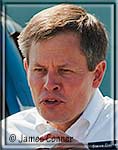
It seems so. Two days ago, Rep. Steve Daines voted for Rep. Michael Burgess’ light bulb amendment to the Energy and Water Development and Related Agencies Appropriations Act (HR-4923). A favorite with tea party Republicans, Burgess’ amendment prohibits the Energy Department from enforcing energy efficiency standards for light bulbs — standards that President George W. Bush signed into law in 2007.
Burgess argues that the marketplace, not government, should set energy efficiency standards. He also believes Americans have a right to buy any kind of light bulb they want; even bulbs that are energy hogs; even bulbs that are dangerous. For Burgess, and for Shutdown Steve, it’s an issue of personal liberty that transcends society’s interest in greater energy efficiency and the environmental benefits thereof. Besides, they argue, energy efficient light isn’t as eye-pleasing as good old incandescent light:
Burgess and others who have come to see the requirements as symbols of government overreach complain the LED and compact fluorescent bulbs effectively required by the standards are too costly and don’t give off the same quality of light.
“The people should have the option of buying the type of light bulb they want,” Burgess said. Bloomberg.
What makes this amendment, and the Republican opposition to the energy standards that Dubya signed into law, so strange is that the marketplace already has said “yes” to the energy standards. According to Bloomberg’s climate blog:
Light bulb manufacturers oppose the amendment, but have said they plan to comply with the efficiency standards whether they are enforced or not, according to the National Electrical Manufacturers Association, which represents companies such as Philips Lighting Co., GE Lighting, Cree Inc. and Osram Sylvania Inc.
“We have not changed our position opposing the amendment,” Phallan K. Davis, a spokeswoman for the Rosslyn, Va. –based trade group, told Bloomberg BNA. “DOE should have the funding to enforce and defend the statute.”
The amendment also is opposed by environmental groups such as the Natural Resources Defense Council, which has said compliance with the light bulb standards will result in savings of nearly $13 billion a year, electricity savings equivalent to 30 large power plants and reduced carbon dioxide emissions of about 100 million tons of carbon a year.
“These companies have made major investments and thoroughly upgraded and retooled their supply chains to comply with the law,” the NRDC said in a July 7 blog post.
How, I wonder, does Daines reconcile his enthusiasm for electricity guzzling incandescent lamps with his avowed determination to protect the North Fork of the Flathead from coal mining in the North Fork’s headwaters basin in British Columbia? Is it because the coal that would have been mined there would have been sold to East Asian nations for use as metallurgical coal in iron smelters? Or is it because he can’t see the light on energy efficiency because he’s blinded by Ayn Rand Lite?
Some years ago, I replaced most of my incandescent lamps with spiral compact fluorescent bulbs with a color temperature of 2700°K, the color temperature of household incandescent bulbs. Because CFLs use one-fourth as much energy to produce the same amount of light as an incandescent bulb, I found I no longer needed an air conditioner in my library, where bright lights are necessary for comfortable reading. And the light quality of CFLs? I found it very pleasing. Furthermore, as a photographer I found it just as photographically acceptable as incandescent light.
Household LEDs, in my experience, do not produce light as pleasing as light from CFLs. I use LED bulbs in two outdoor fixtures, but the light has a distinct yellow-green cast to it that would be unpleasant in my library. Other LEDs are too white for my taste for indoor living space lighting, but are fine for flashlight, work lights, and photography. Moreover, the technology, still a few years behind CFLs, improves rapidly so the day when affordable LED lights with an apparent black-body output is not far off.
Most of the Incandescent Caucus’ complaints that energy efficient light is ugly are simply ugly distortions of fact by zealots who see red, and turn red, at the thought that energy efficient lighting is good for humankind.